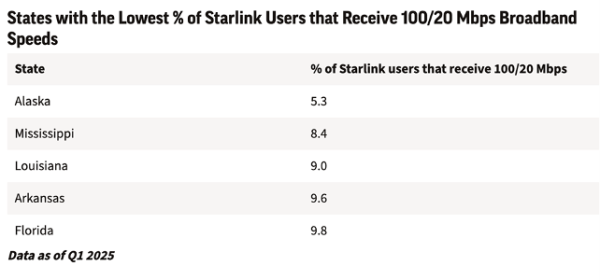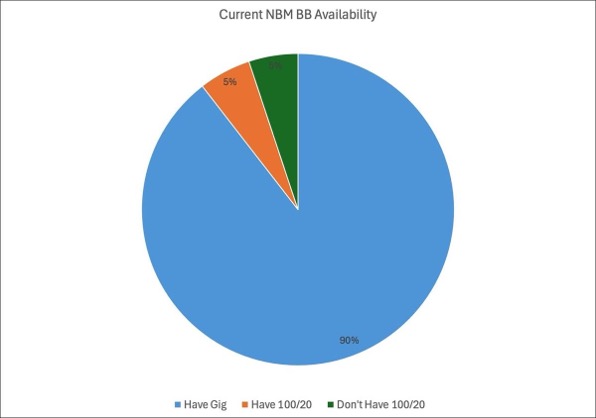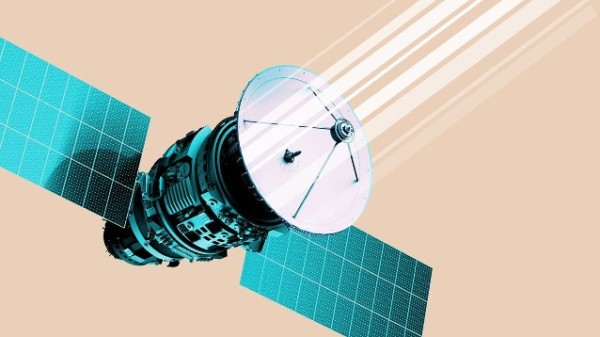Is Starlink Priority Broadband for BEAD?
June 20, 2025
The critical question of the moment:
- The Commerce Department’s new BEAD rules now ensure that Elon Musk’s Starlink qualifies for BEAD funding. But does it qualify for priority BEAD funding?
A few weeks ago, I said Starlink was Schrödinger’s broadband: both broadband and not broadband at the same time.
- On one hand, Starlink is not considered broadband for purposes of counting “served” locations;
- On the other hand, it IS generally considered broadband for purposes of qualifying for BEAD broadband funding — in the same locations, at the same time.
The way to square this circle is to recognize that Starlink today is not broadband.
- Starlink would have defaulted on its RDOF obligations had it been awarded funding because it does not consistently and reliably meet the requisite speed criteria for broadband.
- But the current Administration hopes that Starlink one day in the next four years will do so. That’s why this Administration is allowing Starlink to get BEAD funding now.
To receive federal funds, like RDOF or BEAD, an internet service provider must do more than advertise the availability of a speed; it must pass a series of speed tests that demonstrate those speeds.
- While Starlink advertises and sells 100/20 Mbps, it does not yet meet the FCC’s or NTIA’s speed test regimen for those speeds.
- That’s why Starlink did not qualify for RDOF, though it may qualify for BEAD funds.
The Speed Tests:
Ookla just released its most recent data on Starlink’s speed tests, which showed Starlink delivers 100/20 Mbps just 17.4% of the time.
- The FCC and NTIA require delivery of the requisite speeds at least 80% of the time.
- Ookla also provided its data by state, with the poorest-performing states below:

Source: Ookla at https://www.ookla.com/articles/starlink-us-performance-2025?utm_source=substack&utm_medium=email
Why it matters:
- You’re reading this right. Starlink, in Alaska and in southern U.S. states, delivers its advertised speed to its customers less than 10% of the time when those customers perform speed tests.
- Like millions of Americans, I subscribe to many services, not just telecommunications and broadband services, but entertainment services like Netflix, sports services like the NFL, NBA, and MLB packages, news services, delivery services, and on and on.
- If I could stream a football game only 8.4% of the time, if my food was delivered by DoorDash only 5.3% of the time, if I sat on my couch to chill and could watch a movie only 9.6% of the time, I’m not getting what I paid for.
Fortunately for Starlink, former FCC Chairwoman Rosenworcel did not award Starlink the $885.5 million that it won in the RDOF auction.
If it had, Starlink would have been required to perform as advertised.
And it’s quite likely (given Ookla’s data) that Starlink would have not performed, been found in default of its RDOF obligations and then prohibited from participating in BEAD.
Assuming Starlink will improve its service over the next several years, does Starlink’s service meet the definition of a “Priority Broadband Project” under the BEAD program?
No.
Defining a ‘Priority Broadband Project’

Fortunately for rural America, Congress included a provision in the BEAD legislation that allows states to prioritize broadband projects that can easily scale.
Specifically, a “Priority Broadband Project” under the IIJA (codified at 47 U.S.C. § 1702(a)(2)(I)) is as follows:
“The term ‘priority broadband project’ means a project designed to—
(i) provide broadband service that meets speed, latency, reliability, consistency in quality of service, and related criteria as the Assistant Secretary shall determine; and
(ii) ensure that the network built by the project can easily scale speeds over time to—
(I) meet the evolving connectivity needs of households and businesses; and
(II) support the deployment of 5G, successor wireless technologies, and other advanced services.” (emphasis added)
This language directs NTIA and the states to ensure rural America won’t be left with substandard service. Again.
- Some networks can easily scale (increase capacity and speeds) over time, such as those that already deliver multi-gigabit services.
- Some networks already support the deployment of 5G and will support successor wireless technologies.
Let’s take this definition subpart by subpart.
“(i) provide broadband service that meets speed, latency, reliability, consistency in quality of service, and related criteria as the Assistant Secretary shall determine;”
Under the Commerce Department’s new guidance, the Assistant Secretary of Commerce has determined that, with respect to speed, states now cannot require speeds of more than 100/20 Mbps. Previous rules made 100/20 Mbps the minimum speeds that states could require, with the flexibility to require higher speeds.
What was once a floor, is now the ceiling in the new guidance.
- That determination is counter to every competitive funding program since President Trump first took office in 2016.
- Every competitive program has funded multiple tiers and allowed gigabit-capable networks to be prioritized over less capable networks.
- Indeed, over 95% of the Trump Administration’s RDOF program awards were for networks at the gigabit speed tier.
Go Deeper into Defining

Look at the graph above:
For the first time since President Trump took office in 2016, the broadband performance standard for taxpayer-funded networks in rural areas will be lower than the level of service available to 90% of the country.
According to the most recent data from the National Broadband Map:
- 90% of broadband serviceable locations have access to a minimum of 1 gigabit service. (A growing number now have access to multi-gigabit service.)
- 5% have access to 100/20 Mbps service, which is the current FCC speed definition of broadband.
- 5% do not have access to 100/20 Mbps, which are the locations now eligible for BEAD funding.
While the government’s current definition of broadband in terms of speeds is 100/20 Mbps, the government’s definitions over the years have demonstrably lagged behind the market.
- Spending any taxpayer money on 100/20 Mbps networks when more than 90% of the country has access to gigabit and multi-gigabit services is both wasteful and inefficient.
- Spending $40 billion of taxpayer money this way is not only egregiously wasteful and inefficient; it also will lead to more and more unnecessary spending years down the line.
If the definition of a “priority broadband project” was limited to subpart (i), Starlink might qualify. But such projects must meet both (i) and (ii).
Next subpart:
“(ii) ensure that the network built by the project can easily scale speeds over time to—
(I) meet the evolving connectivity needs of households and businesses; and
(II) support the deployment of 5G, successor wireless technologies, and other advanced services.”
I’m just going to address the evolving broadband needs of households and businesses. What are the evolving connectivity needs?
Over 90% of the country has access to gigabit and multi-gigabit services.
- For Conexon, two-thirds of our customers subscribe to gigabit and multi-gigabit services, all of whom live in rural areas.
- The best indications of the connectivity needs of households and businesses are the network investments made by industry and customer subscription choices and data.
- At a minimum, the connectivity needs are networks capable of delivering gigabit and multi-gigabit service. Today.
The Evolution of Starlink

Back to Starlink.
How has Starlink’s network evolved since launch?
Starlink’s constellation of satellites is an impressive engineering feat.
- Since the first launch of 60 satellites on May 23, 2019, Starlink has launched over 9,000 satellites, of which 1,200 have failed or deorbited. Starlink’s satellites are designed to last five years and then deorbit, so the first year’s satellites are likely no longer in service.
- Of the 7,800 satellites in orbit, nearly 7,000 are fully functional. That’s nearly two-thirds of all active satellites around the globe. Again, an impressive feat.
- The FCC granted Starlink authorization to launch an initial 12,000 satellites by November 2027. Beyond that initial constellation, SpaceX has sought permission with the ITU for 42,000 satellites.
How has Starlink’s customer base grown since launch?
Starlink’s subscriber growth also has been impressive. According to the latest publicly available data, Starlink reported over 1.5 million U.S. customers, and that number is likely higher today.
How has Starlink performed in delivering its advertised speed of 100/20 Mbps over time?
In short, not impressively. The following two charts come from Ookla’s speed tests (i.e., 50% receive the median speed displayed in the chart or faster; 50% receive that speed or slower).


As Starlink has added customers and launched satellites, it has struggled to reliably and consistently deliver its advertised speeds. In some parts of the U.S., Starlink has failed to deliver.
To be clear, other technologies, such as cable and wireless, also overpromise and underdeliver.
But when taking public funds, an ISP must meet certain FCC speed test thresholds.
- Those same protocols have been adopted for the BEAD program.
- When Conexon conducted its speed tests, pursuant to the FCC’s protocols for RDOF, we delivered greater than our requisite speed (1 Gbps/500 Mbps) 99.98% of the time.
The immediate question is not whether Starlink has failed to deliver 100/20 Mbps in the past.
The question is whether its network is easily scalable to deliver gigabit and multi-gigabit services to Louisiana, Mississippi, Arkansas, Alaska, and other places where it currently struggles just to deliver 100/20 Mbps.
- Can Starlink deliver gigabit services to every BEAD location in those states? The answer appears to be no.
- Starlink will need more satellites, likely more than its currently authorized number of 12,000, and more spectrum than currently authorized by the U.S. and other countries.
Bringing It All Together

While SpaceX and Starlink may continue to impress, it would be a stretch to determine that their network is easily scalable.
Some technologies and some networks easily scale, and others do not.
A technologically rigorous neutral approach focuses on capability and performance. The new BEAD guidance references this provision as follows:
“Priority Broadband Project—The term “Priority Broadband Project” means a project that provides broadband service at speeds of no less than 100 megabits per second for downloads and 20 megabits per second for uploads, has a latency less than or equal to 100 milliseconds, and can easily scale speeds over time to meet the evolving connectivity needs of households and businesses and support the deployment of 5G, successor wireless technologies, and other advanced services.”
Furthermore, even priority broadband projects must not waste taxpayer money. As the new guidance states, if a state “determines that selecting a Priority Broadband Project would incur excessive costs, it shall select a lower cost non-Priority Broadband Project.”
- Over the past decade, there have been numerous cost studies conducted by the FCC and telecommunications consultants to determine appropriate costs. The new rules permit applicants to remove extremely high-cost locations, which will help reduce the cost of Priority Broadband Projects.
- At the same time, avoiding excessive spending means the government should exclude projects that do not consistently and reliably deliver the requisite service and will not be considered broadband just a few years from now.
- As a nation, we have been penny wise and pound foolish – repeatedly skimping on services for rural areas.
We need to learn that investing for the short term has been more costly than investing for the long term. And insist that the BEAD program is best used for long-term investment in rural America.
